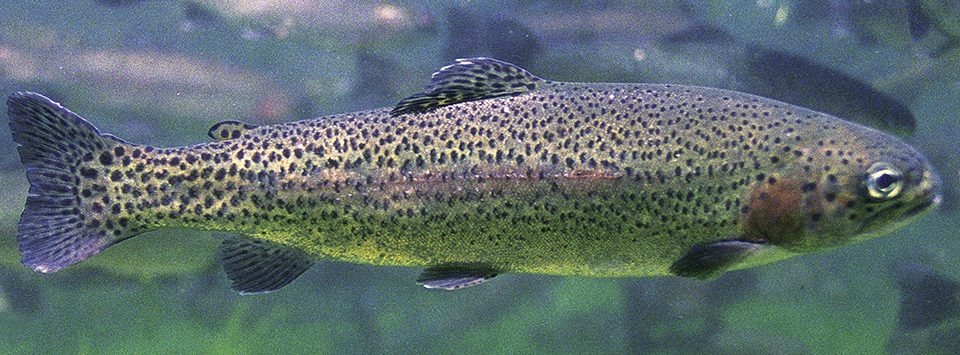Light-control hatchery will provide greater egg availability

Fish are the third most commonly used experimental research animal after mice and rats in some countries. This is a result of the rapid development of the aquaculture industry, regulatory requirements for testing involving fish as indicators of environmental change and the use of fish as a replacement for mammals in biomedical, pharmacological and genetic research.
Aquatic species such as zebrafish, fugu, rainbow trout, catfish, Atlantic salmon, tilapia and bivalves are exclusively used in several scientific and agricultural research programs.
Genetic background relevance
Slight variations in study conditions such as water temperature or quality, feeding level or frequency, or methods of analysis among laboratories are often offered as explanations for differences in results. However, discrepancies in experimental results sometimes are not due to experimental procedures or analysis, but instead to differences in the genetic background of the animals used in the studies. Genetic diversity is believed to be the basis for these differences.
Rainbow trout
Among farmed fish, one of the most intensively studied species is rainbow trout, because of its intensive and long-term use as both a sport and food fish. This species has proven to be an outstanding model for physiological and genetic studies. A number of genomic tools are already available for rainbow trout research, such as gene sequences, linkage maps, microarrays, and expressed sequence tags and bacterial artificial chromosome libraries.
Rainbow trout are relatively easy and inexpensive to culture. Studies can be performed on small fish, saving space and maximizing water availability, or on larger fish, which are more suitable for surgical manipulation and the isolation of distinct tissues and organs.
Reproduction in rainbow trout is well understood and can be manipulated to spawn fish at any time of the year. Furthermore, information and methods are available for chromosomal manipulation and sex reversal such that haploid, triploid or tetraploid fish, or monosex populations can be produced. Finally, several distinct domesticated strains are available, along with nonselected cultured strains and fish from the wild.

Stock development
Most rainbow trout stocks used in research studies come from eggs purchased from commercial suppliers, local broodstock, academic stocks or wildlife management facilities. Such stocks often differ in their responses to dietary treatments.
To alleviate problems associated with conducting research studies with fish of unknown and likely quite diverse genetic backgrounds, a collaborative project has been established by the University of Idaho, United States Department of Agriculture Agricultural Research Service and U.S. Soybean Board to produce a stock of rainbow trout with a defined genetic background for use in fish nutrition research.
This stock will be derived from an equal crossing of the University of Washington Donaldson strain obtained from the National Center for Cool and Cold Water Aquaculture (NCCCWA) and the Housecreek strain from the College of Southern Idaho. Both strains are highly domesticated and have been used in research studies for years. Since these stocks are also being used in the NCCCWA rainbow trout selection program, the current genomic tool set will be directly applicable to this new research line of fish.
An additional benefit of using well-defined research stock will be that new findings from researchers using these stocks can be incorporated into further improving the selected lines at NCCCWA. In the past, quantitative trait loci markers defined in a given trout strain were not always applicable to other strains, limiting their effectiveness for use and evaluation in other strains of rainbow trout.
The goal of the University of Idaho Hagerman Fish Culture Experiment Station is to supply lots of up to 10,000 eggs or several hundred fry upon request. The construction of a new light-control hatchery will provide almost constant year-round availability of eggs. In the future, if researchers are interested in evaluating genetic variations between strains, distinct genetic stocks or specific stock crosses may be made available to the research community.
(Editor’s Note: This article was originally published in the May/June 2009 print edition of the Global Aquaculture Advocate.)
Now that you've finished reading the article ...
… we hope you’ll consider supporting our mission to document the evolution of the global aquaculture industry and share our vast network of contributors’ expansive knowledge every week.
By becoming a Global Seafood Alliance member, you’re ensuring that all of the pre-competitive work we do through member benefits, resources and events can continue. Individual membership costs just $50 a year. GSA individual and corporate members receive complimentary access to a series of GOAL virtual events beginning in April. Join now.
Not a GSA member? Join us.
Authors
-
Ken Overturf, Ph.D.
U.S. Department of Agriculture
Agricultural Research Service -
Ronald Hardy, Ph.D.
University of Idaho
Hagerman Fish Culture Experiment Station
3059-F National Fish Hatchery Road
Hagerman, Idaho 83332 USA
Tagged With
Related Posts

Health & Welfare
Algae shows promise as alternative DHA source in rainbow trout diets
A growth trial in Canada evaluated the use of algae biomass to increase the concentration of long-chain polyunsaturated fatty acids in the tissues of rainbow trout.

Aquafeeds
Alternative lipids spare fish oil in rainbow trout feeds
Alternative lipids have achieved varied success in ensuring adequate growth and fatty acid composition in fillets. The authors evaluated rainbow trout raised on diets containing fish oil or a blend of fish and standard or modified lipids varying in fatty acid composition.

Intelligence
A motive, and a market, for farmed fish in Mexico
Boasting ample areas for aquaculture and a robust domestic demand for seafood – not to mention its close proximity to the U.S. market – a land of opportunity lies in Mexico. Fish farming is primed to meet its potential south of the border.

Health & Welfare
Ammonia toxicity degrades animal health, growth
Ammonia nitrogen occurs in aquaculture systems as a waste product of protein metabolism by aquatic animals and degradation of organic matter, or in nitrogen fertilizers. Exposure can reduce growth and increase susceptibility to diseases in aquatic species.


